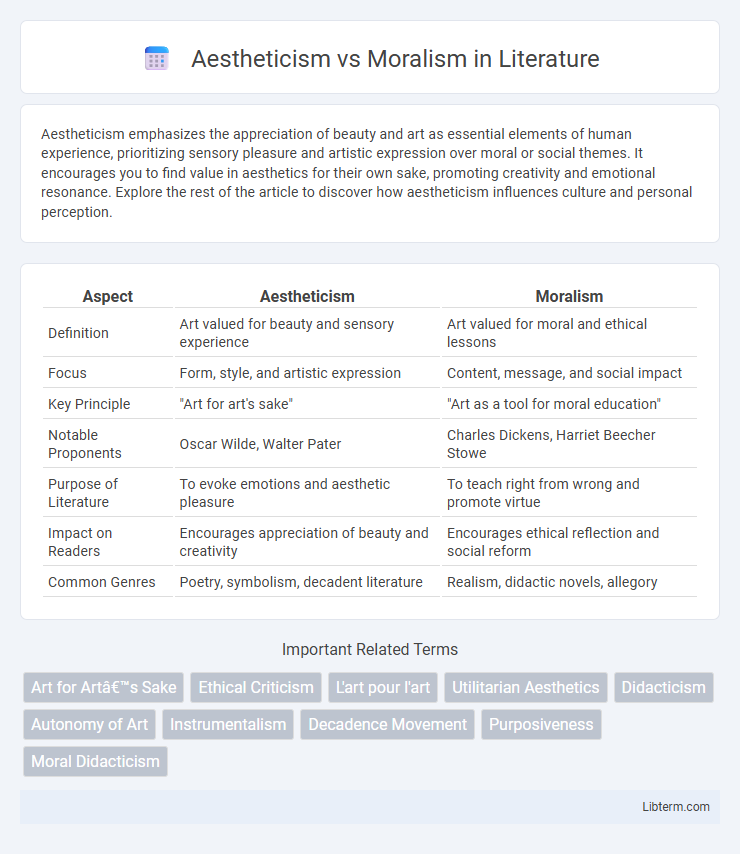Aestheticism emphasizes the appreciation of beauty and art as essential elements of human experience, prioritizing sensory pleasure and artistic expression over moral or social themes. It encourages you to find value in aesthetics for their own sake, promoting creativity and emotional resonance. Explore the rest of the article to discover how aestheticism influences culture and personal perception.
Table of Comparison
| Aspect | Aestheticism | Moralism |
|---|---|---|
| Definition | Art valued for beauty and sensory experience | Art valued for moral and ethical lessons |
| Focus | Form, style, and artistic expression | Content, message, and social impact |
| Key Principle | "Art for art's sake" | "Art as a tool for moral education" |
| Notable Proponents | Oscar Wilde, Walter Pater | Charles Dickens, Harriet Beecher Stowe |
| Purpose of Literature | To evoke emotions and aesthetic pleasure | To teach right from wrong and promote virtue |
| Impact on Readers | Encourages appreciation of beauty and creativity | Encourages ethical reflection and social reform |
| Common Genres | Poetry, symbolism, decadent literature | Realism, didactic novels, allegory |
Introduction to Aestheticism and Moralism
Aestheticism emphasizes the appreciation of art and beauty for their own sake, valuing sensory experience and emotional response above ethical considerations. Moralism, in contrast, prioritizes moral values and ethical lessons in artistic expression, insisting that art should promote virtuous behavior and social norms. The debate between Aestheticism and Moralism centers on whether art's primary purpose is to please the senses or to serve moral and educational functions.
Historical Origins of Aestheticism
Aestheticism emerged in the late 19th century as a reaction against Victorian moralism, emphasizing art's intrinsic value and beauty over social or ethical messages. Rooted in the philosophy of figures like Walter Pater and Oscar Wilde, the movement championed "art for art's sake," rejecting the utilitarian purpose of art as a vehicle for moral education. This historical origin positioned aestheticism as a significant shift in cultural attitudes, prioritizing sensory experience and artistic form above conventional moral judgments.
Key Principles of Moralism
Moralism centers on the notion that art should convey ethical messages and promote virtuous behavior, emphasizing the didactic role of literature and visual art. Key principles include a commitment to social responsibility, reinforcing societal norms and moral values, and often judging artistic merit based on its capacity to instruct or improve the audience's character. Moralism critiques aestheticism's focus on beauty for beauty's sake by asserting that art divorced from ethical considerations lacks meaningful purpose and societal relevance.
Influential Figures in Aestheticism
Oscar Wilde, Walter Pater, and Algernon Swinburne are prominent figures in the Aestheticism movement, championing "art for art's sake" and emphasizing beauty over moral or social themes. Wilde's works, including "The Picture of Dorian Gray," explore aesthetic ideals that challenge conventional morality, while Pater's essays promote the pursuit of intense aesthetic experiences. Swinburne's poetry, rich in sensory imagery and technical mastery, reinforces the movement's focus on art's emotional and aesthetic impact rather than ethical instruction.
Moralism in Art and Literature
Moralism in art and literature emphasizes the ethical and societal lessons conveyed through creative works, often prioritizing moral messages over aesthetic qualities. This approach insists that artworks should promote virtuous behavior, social justice, or moral improvement in audiences, reflecting cultural or religious values. Writers and artists aligned with moralism use narrative, symbolism, and character development as tools to reinforce ethical standards and influence public conscience.
Aestheticism vs Moralism: Core Differences
Aestheticism emphasizes the primacy of beauty and artistic expression over moral or social themes, valuing art for its own sake. Moralism judges art based on ethical and social messages, insisting that art should promote virtue and address moral issues. The core difference lies in Aestheticism's focus on sensory experience and form, whereas Moralism prioritizes didactic purpose and moral accountability.
The Role of Ethics in Creative Expression
The role of ethics in creative expression often sparks debate between aestheticism and moralism, as aestheticism champions art's autonomy from ethical considerations, emphasizing beauty and form above all else. Moralism asserts that creative works bear a social responsibility, promoting ethical values and reflecting moral truths to influence audiences positively. This tension highlights the ongoing conflict over whether art should prioritize aesthetic innovation or serve as a vehicle for moral guidance.
Impact on Modern Culture and Society
Aestheticism, which prioritizes beauty and artistic expression for its own sake, has significantly influenced modern culture by encouraging creative freedom and challenging traditional norms in art, fashion, and literature. Moralism, emphasizing ethical values and social responsibility, continues to shape cultural debates on media content, censorship, and the role of art in reflecting societal values. The dynamic tension between aestheticism and moralism drives ongoing discussions about the purpose of art and its impact on identity, politics, and social change in contemporary society.
Critiques and Controversies
Aestheticism faces critiques for promoting art's detachment from social and ethical responsibilities, often seen as fostering elitism or escapism. Moralism challenges this by insisting art should reflect societal values and ethical norms, but critics argue this risks censoring creative freedom and reducing art to propaganda. The controversy persists as debates revolve around whether art's primary function is to provoke aesthetic pleasure or uphold moral duties.
Reconciliation: Finding a Middle Ground
Aestheticism emphasizes the pursuit of beauty and artistic expression, while moralism prioritizes ethical values and social responsibility. Reconciliation between these philosophies involves integrating aesthetic appreciation with moral considerations, promoting art that enriches both sensory experience and ethical reflection. This middle ground encourages creators to produce works that inspire emotional engagement without compromising moral integrity.
Aestheticism Infographic

 libterm.com
libterm.com